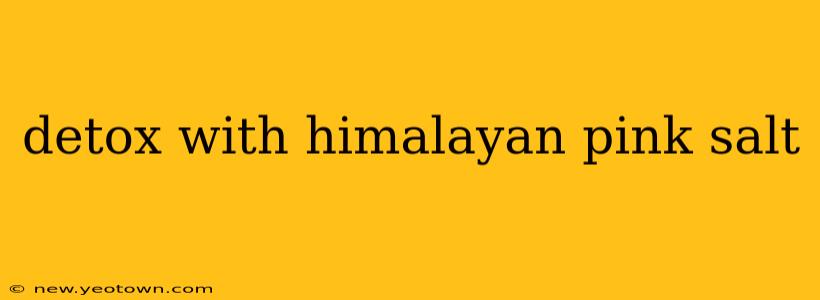The Pink Promise: Exploring Himalayan Pink Salt Detox Baths
For centuries, salt has been more than just a seasoning; it's held a place of reverence in many cultures, revered for its cleansing and healing properties. Now, Himalayan pink salt, with its alluring hue and purported health benefits, is experiencing a surge in popularity, particularly in the realm of detox. But does a Himalayan pink salt bath truly detoxify the body? Let's dive into this fascinating topic and explore the science (and the hype).
Our story begins not in a laboratory, but in the ancient salt mines of the Himalayas. Imagine vast caverns, lit by flickering lamps, revealing walls of crystalline pink salt, millions of years in the making. This salt, unlike its refined white counterpart, is rich in trace minerals like magnesium, potassium, and calcium. It's this mineral richness that fuels the claims surrounding its detoxifying powers.
Does a Himalayan Pink Salt Bath Actually Detoxify?
This is the million-dollar question, isn't it? While the idea of soaking away toxins sounds appealing, the scientific community hasn't definitively proven that a Himalayan pink salt bath directly removes toxins from the body. Our bodies have their own sophisticated systems – the liver and kidneys – for detoxification.
However, that doesn't negate the potential benefits. A warm bath itself can be incredibly relaxing, easing muscle tension and promoting a sense of calm. The minerals in Himalayan pink salt may play a supporting role in this process.
What are the claimed benefits of a Himalayan pink salt bath?
Many believe that a Himalayan pink salt bath offers a range of benefits beyond relaxation:
- Improved skin health: The minerals in the salt may help soothe irritated skin, reduce inflammation, and potentially alleviate conditions like eczema.
- Muscle pain relief: The magnesium in the salt is known for its relaxing properties, which could help ease muscle aches and pains.
- Stress reduction: The warmth of the bath combined with the calming ambiance creates a relaxing experience, contributing to stress relief.
- Improved sleep: The relaxation induced by the bath may promote better sleep quality.
How much Himalayan pink salt should I use in a bath?
The general recommendation is to use approximately 1-2 cups of Himalayan pink salt per bath. However, you can adjust the amount based on your preference and the size of your bathtub. Start with a smaller amount and increase it gradually if needed.
Are there any potential side effects of Himalayan pink salt baths?
While generally safe, some individuals may experience skin irritation or dryness. If you have sensitive skin, it's recommended to start with a small amount of salt and monitor your skin's reaction. Also, individuals with certain medical conditions should consult their doctor before using Himalayan pink salt baths.
Can Himalayan pink salt detoxify the body through other methods?
While baths are popular, Himalayan pink salt can be incorporated into other wellness practices. Some people use it as a mouthwash for oral hygiene or as a component in homemade scrubs. Always ensure you're using food-grade Himalayan pink salt for internal or topical application.
Is Himalayan Pink Salt Better than Epsom Salt for Detox?
Both Himalayan pink salt and Epsom salt (magnesium sulfate) are often used in baths for relaxation and purported detoxification. The main difference lies in the mineral composition. Himalayan pink salt contains a broader range of trace minerals, while Epsom salt is primarily magnesium sulfate. The choice depends on personal preference and specific needs.
Ultimately, while a Himalayan pink salt bath may not be a magic bullet for detoxification, it can be a luxurious and relaxing way to unwind and potentially support your overall well-being. The gentle embrace of warm water, combined with the minerals of this ancient salt, offers a soothing escape from the stresses of daily life. Remember, however, that it's essential to maintain a balanced and healthy lifestyle for optimal detoxification and overall health.

